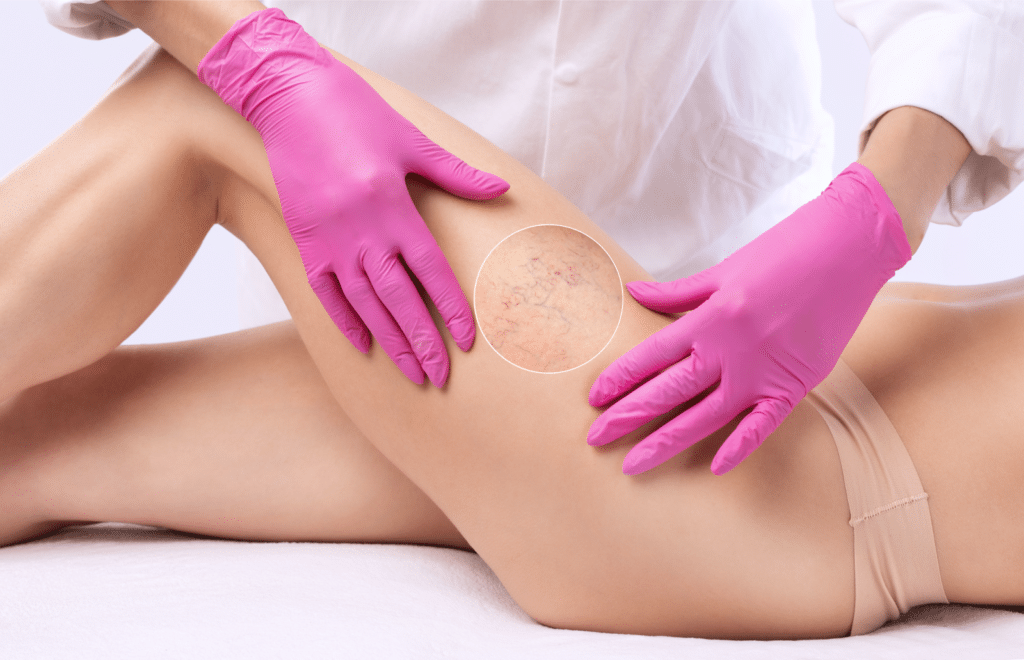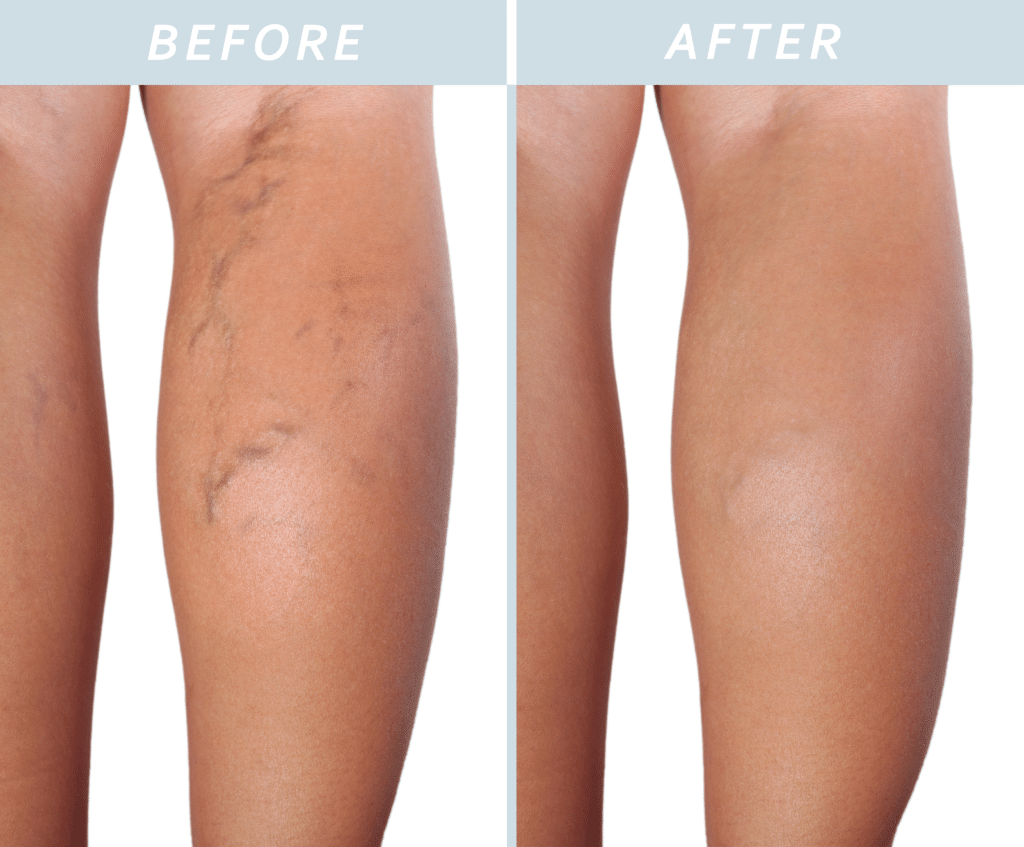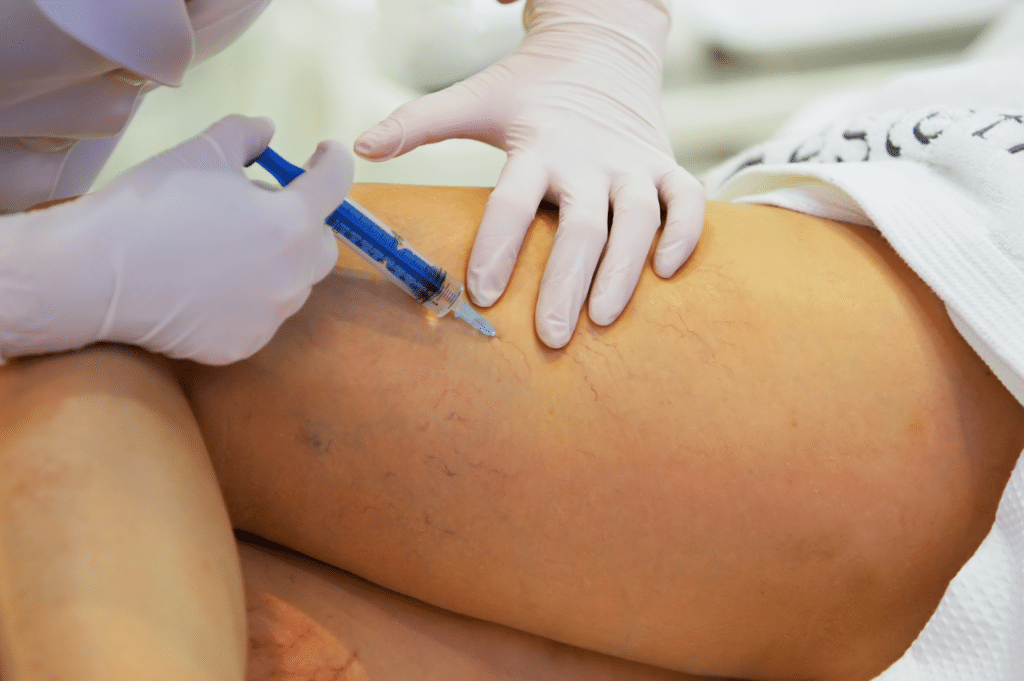Vein disease can appear in a variety of ways, but the two most common forms of vein disease are the appearance of spider and varicose veins. Millions of Americans are impacted by these unsightly veins every year, and they can appear anywhere from your face, all the way down to your hands and feet.

Why Do Spider and Varicose Veins Appear?
In either case, the development of both varicose veins and spider veins is the result of damaged veins in the area they appear in. These veins become pronounced and more visible when the tiny valves inside our veins weaken, causing some blood to flow backward and accumulate in the vein. As extra blood pools, it puts pressure on the walls of the vein. Then, as the pressure builds, the vein walls continue to weaken and begin to bulge outward.
Some people have a higher risk of developing varicose or spider veins due to genetic makeup, but it’s also possible to develop them more easily if you sit or stand for long periods of time very often, if you’re pregnant or just gave birth, if you have other hormonal changes, have high exposure to sunlight, or even just by going through the natural aging process.
Depending on the affected area and whether you have spider veins, varicose veins, or a combination of both, the treatment plan will range in procedure and period of time. But the good news is that both are extremely treatable!
Spider or Varicose Veins On The Face
There is nothing more frustrating – and sometimes very painful – than having unsightly vein disease appear on your face. While both types are possible, spider veins are most commonly the type of visible vein that will appear on the face as a result of venous insufficiency. This type of vein disease appears as thin lines or webs of blue, purple, and red veins. While spider veins are not directly harmful, they can affect your overall appearance.
Spider or Varicose Veins In The Hands
While the face is more susceptible to spider veins, your hands are more prone to varicose veins. You may notice that as we age the veins in our hands will become more prominent. This appearance will only worsen if you develop varicose veins—bulging veins that appear thick and more ropelike.
Spider or Varicose Veins On The Trunk
More severe forms of varicose veins can occur in an area of the body called the trunk, the area of your body from the hips to just below your chest, in which veins run up into your arms. Trunk varicose veins are common for both men than women, and the vein treatment will depend on where on the trunk the area occurs. Your cosmetic physician will walk you through which treatment option will be recommended for you.
Spider or Varicose Veins In On The Legs
Legs are known to be prone to both spider and varicose veins, and it’s not uncommon to have a mixture of both throughout this area. Patients with vein disease typically see most of their more visible veins occur on their legs.

Treating Cosmetic Spider Veins
When it comes to vein disease, spider veins are typically harmless but can be seen all across the impacted area of the body. Spider veins are found close to the surface of the skin, making them easier to find than varicose veins. These cosmetic symptoms make it easy to treat spider veins using Sclerotherapy.
In order to track down minuscule spider veins, Sclerotherapy treatment uses a vein light to help illuminate their presence. This type of spotlight effect makes sure your treatment is as accurate as possible. A sclerosant is then injected into the impacted veins, causing them to close and disappear over time. Although they aren’t a health threat, spider veins can be an indication of further trouble to come, so it is best to treat them early and pinpoint their cause.
Multiple Treatments for the Best Results
Similar to other cosmetic procedures, sclerotherapy requires multiple treatment rounds in order for you to see the best results and will be determined by how long it may take to have some veins permanently close. Every treatment of sclerotherapy has a limitation on the size of vein closure it can perform, and on average it takes around two or three treatment cycles to see a long-lasting closure. Occasionally, parts of a treated vein may reopen between treatments and need to be treated again.
Determining the length of treatment cycles all depends on how your body responds to the initial round of treatments. However, when you choose the professionals at the Laser Vein Center, you are choosing some of the most trusted physicians in the field. We will make sure each treatment cycle for your plan is handled with the utmost care so you can avoid any unnecessary side effects.
Treating Varicose Veins
Unlike spider veins, varicose veins are large and have a rope-like appearance bulging out of your skin. While this can also be a cosmetic issue affecting the way you feel, it can also lead to eventual medical issues and these veins tend to be more painful. If untreated, varicose veins can lead to blood clots, ulcers, sores on your legs, and chronic inflammation.

Ultrasound Guided Sclerotherapy
A typical treatment procedure will start by finding any varicosities and venous insufficiency occurring in the body. By treating the underlying problem, we can effectively provide long-term relief. Finding the refluxing saphenous vein is done by using ultrasound technology, which is projected onto your skin’s surface before the impacted area is found. As we monitor the ultrasound on screen, we will begin administering the numbing liquid, a sclerosant, ensuring only the varicose veins are administered the solution. With sclerotherapy, we can avoid more invasive treatment options such as vein stripping. Dealing with varicose veins at an early stage is the only way to avoid future health issues caused by damaged veins.
Endovenous Laser Ablation
This treatment can be performed right in our office so no visit to the hospital is required. Endovenous laser ablation only requires a local anesthetic and a small incision, after which a laser will seal the impacted vein. The vein will eventually be absorbed back into your body, which naturally redirects blood flow through the other healthy veins in the area.
Patients recover extremely quickly and are able to walk right after the procedure is completed. Some patients may experience discomfort following the procedure, but over-the-counter pain medication will help with any pain. An alternative to endovenous laser ablation is radiofrequency ablation that works in a similar fashion but instead uses radiofrequency waves instead of a laser.
Radiofrequency Ablation
Another option that works similar to endovenous laser treatment is called radiofrequency ablation. This procedure also uses a tiny probe and is inserted into the problem vein. Instead of laser energy, this procedure will direct radiofrequency energy to heat up the vein and cause it to collapse. This collapsed vein will also be safely absorbed into your body and blood flow will be naturally redirected. After the treatment is complete your treatment area will start to regain its previous appearance. Most individuals can head home right after the treatment is complete. The usual side effects include some swelling around the treated area but will heal quickly especially when compression stockings are worn. Most people return to full activities 48 hours later and the cosmetic results are excellent.
Vein Phlebectomy
While some options such as vein stripping are more invasive, we typically recommend a minimally invasive treatment first like vein phlebectomy. This procedure is similar to vein stripping, as it physically removes the faulty veins, but does so in a way to reduce the length of your recovery time.
Vein phlebectomy works by numbing the treatment area and using a scalpel to make tiny incisions along the vein line. This incision will allow us to insert a small hook under the skin to remove the faulty veins. This is one of our most successful treatment options as it boasts over a 90% success rate! Our physicians can complete your vein phlebectomy in under an hour.
While some patients may initially think a vein phlebectomy will take weeks to heal, you will be pleasantly surprised to know that is not the case. Since the incisions are so small, your treated area will not require any stitches. Instead, we will apply a compression garment that will help blood flow and promote overall healthy healing. Some patients may even be able to return to daily activities within 24 hours while strenuous physical activity is not recommended until two weeks after the procedure is complete.

Have More Questions? We’re here to help!
Have more questions about your veins or possible treatment options? Perhaps the best part of getting vein treatment is how easy it is to start the process! It’s as simple as contacting St. Louis Laser Vein for an open appointment, discussing your ideal outcomes with Dr. Wright and our team, and getting the treatment scheduled! We’re here to help talk through what you’re looking for and how we can help you get those desired results to feel your best!
Contact St. Louis Laser Vein today to speak with Dr. Wright and his team of experts. He’s here to help answer your questions and concerns, and help you decide on what plan might work best for you!

